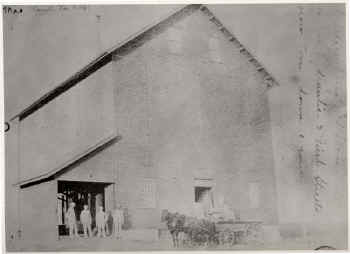|
Then and Now: Hydraulic Mills
|
|
|
THEN: View of the Hydraulic Mills about 1874, located at Hydraulic and First Streets. Although the old photograph is of poor quality, the basic features of the three story brick structure are
observable. |
|
|
| The illustration at left, based on a 1880s Sanford Insurance map, shows an outline of the first mill, the dam on Chisholm Creek, the waterwheel and tail race. The mill ran on water power for the first few years of its existence before converting to steam power. Over the years, Chisholm Creek was channeled into the Drainage Canal. |
|
|
| NOW: Chisholm Creek and the mill are long gone, but the corner still bears the street names of Hydraulic and First. |
In the early days of Wichita, it was known as "Mill Street." Now it is known as Hydraulic Street, and people often ask, "How did the name originate?"
The answer is simple. The street ran by the water-powered Hydraulic Mills, located at what is now Hydraulic and First Streets.
According to the Wichita Beacon, June 20, 1901, the Hydraulic Mills was the first mill in southwest Kansas and had a capacity of 250 barrels a day. It was the largest mill in the state.
The first mill ran on water power from Chisholm Creek, now diverted into the drainage canal. Apparently it was not very successful and soon failed, probably due to lack of sufficent water flow. But in 1881, the mill had a rebirth and was reconstructed.The old upper foundations and wall were retained, but a new mill was built 25 feet from the stream, and power was transferred from the turbine by shafts.
According to William G. Cutlerís History of the State of Kansas, in 1881, buildings were erected at the previous old site by Hiram Lewis and John and Ben Deffenbaugh. They commenced operation of this new mill in October of that year.
Needing more water flow, they contracted with Arthur Sullivan, who had a dam built in 1872 on the Little Arkansas River, five miles above the mill. By means of a sluiceway, water was diverted from the river to Chisholm Creek.
The Dec. 8, 1881, Wichita Eagle, stated, "Water in the forebay stands nine feet over the single Victor turbine at the bottom, which gives twice the power of all three Lefel wheels in the old mills." The water power was estimated at 80 horsepower.
The mill was a four and one-half story frame building, made of white pine. It rested on a stone foundation and was 40 x 56 feet in size. It used four sets of buhrs (millstones) and had a storage capacity of 12,000 bushels of grain. In 1884, the mill was converted to a roller mill, and, in 1886, a corn mill was added.
By 1891, the city fathers were growing very unhappy with the mill pond and its effect on the Little Arkansas River and in June passed an ordinance condemining the pond. The following September, the city took formal possession of the dam and destroyed it by opening the center of it and releasing the standing water. The mill converted to steam and continued operation, but it was torn down in 1901.
08/19/03
